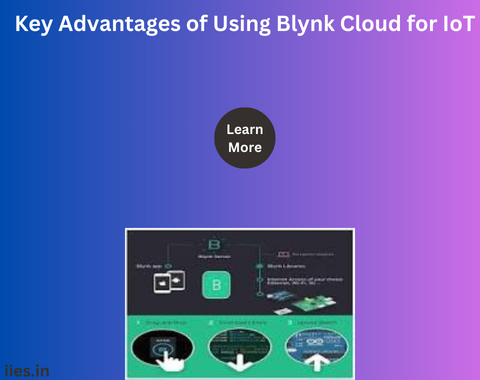
In the dynamic realm of the Internet of Things (IoT), the Blynk Cloud has emerged as a transformative platform, empowering developers and enthusiasts to create innovative and connected projects seamlessly. Blynk Cloud serves as the backbone for the Blynk ecosystem, offering a cloud-based solution that facilitates the communication between devices and the Blynk mobile app. This article aims to delve into the fundamental aspects of Blynk Cloud, exploring its features, benefits, and applications in the IoT landscape.
Blynk Cloud is a cloud-based server that acts as an intermediary between IoT devices and the Blynk mobile app. It enables users to build connected projects without the need for extensive backend infrastructure or server management. At its core, Blynk Cloud simplifies the process of connecting hardware to the internet, making IoT development accessible to a broad audience.
1. User-Friendly Interface:
Blynk Cloud provides a user-friendly interface that allows both beginners and experienced developers to create IoT projects effortlessly. The drag-and-drop functionality of the Blynk app interface makes it easy to design custom user interfaces for controlling and monitoring connected devices.
2. Wide Range of Supported Hardware:
One of the strengths of Blynk Cloud is its compatibility with a diverse array of hardware platforms. Whether it’s Arduino, Raspberry Pi, ESP8266, or other popular microcontrollers, Blynk Cloud supports a wide range of devices, offering flexibility to developers and ensuring that they can work with their preferred hardware.
3. Widgets for Interactivity:
Blynk Cloud incorporates a variety of widgets that enhance interactivity in IoT projects. Widgets such as buttons, sliders, gauges, and graphs can be easily added to the Blynk app interface, providing users with a visual and interactive means to control and monitor connected devices.
4. Real-Time Data Visualization:
Blynk Cloud facilitates real-time data visualization by allowing users to create dynamic dashboards. This feature is particularly valuable for applications where monitoring and analyzing data in real-time is crucial, such as in smart home systems or industrial automation.
5. Cloud Integration and Data Storage:
Blynk Cloud seamlessly integrates with popular cloud platforms, enabling users to store and retrieve data. This integration is useful for scenarios where historical data analysis or cloud- based services are essential components of the IoT application.
Setting up Blynk Cloud involves a straightforward process:
1. Create an Account:
Users start by creating an account on the Blynk app, available on both iOS and Android platforms.
2. Create a New Project:
After logging in, users can create a new project and select the hardware they are using.
3. Get Auth Token:
Each project on Blynk Cloud is assigned a unique authentication token. This token is crucial for connecting the hardware to the Blynk Cloud.
4. Add Widgets:
Users can then add widgets to their project, defining the user interface elements that will control or display information from the connected devices.
5. Upload Code to Hardware:
Once the project is configured in the Blynk app, users need to upload the corresponding code to their hardware, integrating it with the Blynk Cloud.
1. Smart Home Automation:
Blynk Cloud is widely used in smart home projects, allowing users to control lights, thermostats, security cameras, and other devices from their smartphones. The real-time data visualization feature is particularly beneficial for monitoring home parameters.
2. IoT Prototyping:
Blynk Cloud is a go-to platform for IoT prototyping, enabling developers to quickly build and test their ideas. Its compatibility with various hardware platforms and extensive library support streamlines the prototyping process.
3. Industrial IoT (IoT):
In industrial settings, Blynk Cloud finds applications in monitoring and controlling machinery, tracking production metrics, and optimizing processes. The ability to integrate with cloud platforms makes it suitable for data storage and analytics in industrial IoT applications.
4. Education and Learning:
Blynk Cloud is an excellent educational tool for teaching IoT concepts. Its user-friendly interface, coupled with a vast community and documentation, makes it accessible for students and hobbyists exploring IoT development.
While Blynk Cloud has gained widespread popularity, it is not without its challenges:
1. Dependency on Blynk Servers:
The reliance on Blynk Cloud servers for communication between devices and the mobile app can be a potential point of concern. Users are dependent on the availability and reliability of these servers for their projects to function seamlessly.
2. Limited Customization for Advanced Users:
While Blynk Cloud provides a user-friendly interface for beginners, some advanced users may find its customization options limiting. For those seeking more extensive control and flexibility, a self-hosted Blynk server might be a preferable option. Looking ahead, Blynk is continually evolving, and future developments may address current challenges and introduce new features. The community-driven nature of Blynk ensures that user feedback plays a crucial role in shaping the platform’s roadmap.
Blynk Cloud stands as a testament to the democratization of IoT development, making it accessible to a broad audience, from beginners to experienced developers. Its intuitive interface, compatibility with diverse hardware, and range of features contribute to its widespread adoption in various IoT applications. As the IoT landscape continues to expand, Blynk Cloud remains a powerful tool for those looking to bring their connected projects to life without the complexities of managing backend infrastructure. Whether’s for smart homes, industrial applications, or educational purposes, Blynk Cloud continues to be a driving force in the world of Internet of Things.
Indian Institute of Embedded Systems – IIES